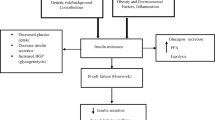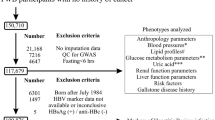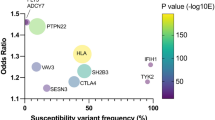Abstract
Gastric cancer (GC) is a common and complex disease caused by multifactors. The aim of our study was to investigate the association of the common polymorphisms detected in insulin-like growth factor (IGF)-II, IGF-1 receptor, insulin-like growth factor binding protein 1 (IGFBP1), insulin (INS) and tyrosine hydroxylase (TH) with susceptibility to GC in a northwestern Chinese population. One hundred and fifty-four GC patients and 166 healthy controls were investigated in our study. The genotypes were determined by polymerase chain reaction-restriction fragment length polymorphism. The frequencies of CC and CT genotypes of TH were significantly higher in GC patients than in controls, as the odds ratios were 3.03 (95%CI 1.438–6.362, P=0.003) and 1.97 (95%CI 1.218–3.167, P=0.005), respectively. No association was found between the polymorphisms of IGF-II ApaI, insulin-like growth factor-1 receptor MnlI, IGFBP1 Bgl II and INS-23HphI and the development of GC. The presence of CC and CT genotypes of TH was associated with a significantly increased risk of GC. But the polymorphisms of other genes detected did not indicate an increased risk of GC in the investigated population.
Similar content being viewed by others
References
Roder DM (2002) The epidemiology of gastric cancer. Gastric Cancer 5:5–11
Sun XD, Mu R, Zhou YS (2002) The investigation and analysis on mortality of gastric cancer in China between 1990–1992. Chin J Oncol 24:4–8
Fuchs CS, Mayer RJ (1995) Gastric carcinoma. N Engl J Med 333:32–41
Grimberg A, Cohen P (2000) Role of insulin-like growth factors and their binding proteins in growth control and carcinogenesis. J Cell Physiol 183:1–9
Khandwala HM, McCutcheon IE, Flyvbjerg A, Friend KE (2000) The effects of insulin-like growth factors on tumorigenesis and neoplastic growth. Endocr Rev 21:215–244
Hernandez-Sanchez C, Werner H, Roberts CT Jr (1997) Differential regulation of insulin-like growth factor-I (IGF-I) receptor gene expression by IGF-I and basic fibroblastic growth factor. J Biol Chem 272:4663–4670
Powell DR, Suwanichkul A, Cubbage ML et al (1991) Insulin inhibits transcription of the human gene for insulin-like growth factor-binding protein-1. J Biol Chem 266:18868–18876
Lee PD, Giudice LC, Conover CA, Powell DR (1997) Insulin-like growth factor binding protein-1: recent findings and new directions. Proc Soc Exp Biol Med 216:319–357
Vadgama JV, Wu Y, Datta G et al (1999) Plasma insulin-like growth factor-I and serum IGF-binding protein 3 can be associated with the progression of breast cancer, and predict the risk of recurrence and the probability of survival in African-American and Hispanic women. Oncology 57:330–340
Agurs-Collins T, Adams-Campbell LL, Kim KS, Cullen KJ (2000) Insulin-like growth factor-1 and breast cancer risk in postmenopausal African-American women. Cancer Detect Prev 24:199–206
Harman SM, Metter EJ, Blackman MR et al (2000) Serum levels of insulin-like growth factor I (IGF-I), IGF-II, IGF-binding protein, and prostate-specific antigen as predictors of clinical prostate cancer. J Clin Endocrinol Metab 85:4258–4265
Stattin P, Bylund A, Rinaldi S (2000) Plasma insulin-like growth factor-I, insulin-like growth factor-binding proteins, and prostate cancer risk: a prospective study. J Natl Cancer Inst 92:1910–1917
Palmqvist R, Hallmans G, Rinaldi S (2002) Plasma insulin-like growth factor 1, insulin-like growth factor binding protein 3, and risk of colorectal cancer: a prospective study in northern Sweden. Gut 50:642–646
Lukanova A, Toniolo P, Akhmedkhanov A (2001) A prospective study of insulin-like growth factor-I, IGF-binding protein-1,-2 and-3 and lung cancer risk in women. Int J Cancer 92:888–892
Pavelic K, Kolak T, Kapitanovic S (2003) Gastric cancer - the role of insulin-like growth factor 2 (IGF 2) and its receptors (IGF 1R and M6-P/IGF 2R). J Pathol 201:430–438
Gary SG, Kjellman M, Larsson C, Ekstrom TJ (1997) Novel splicing of an IGF2 polymorphic region in human adrenocortical carcinomas. Biochem Biophys Res Commun 239:878–883
Laukkanen O, Pihlajamaki J, Lindstrom J (2004) Common polymorphisms in the genes regulating the early insulin signaling pathway: effects on weight change and the conversion from impaired glucose tolerance to type 2 diabetes. Diabetologia 47:871–877
Ukkola O, Sun G, Bouchard C (2001) Insulin-like growth factor 2 (IGF2) and IGF-binding protein 1 (IGFBP1) gene variants are associated with overfeeding-induced metabolic changes. Diabetologia 44:2231–2236
Ho GYF, Melman A, Liu SM, Li M (2003) Polymorphism of the insulin gene is associated with increased prostate cancer risk. Br J Cancer 88:263–269
Gomez O, Balsa JA (2004) Implication of pituitary vasoactive intestinal peptide in dopaminergic inhibition of estrogen-induced pituitary hyperplasia and vascular endothelial growth factor expression. Neuroendocrinology 80:324–331
Sarkar C, Chakroborty D, Mitra RB et al (2004) Dopamine in vivo inhibits VEGF-induced phosphorylation of VEGFR-2, MAPK, and focal adhesion kinase in endothelial cells. Am J Physiol Heart Circ Physiol 287:1554–1560
Basu S, Sarkar C, Chakroborty D (2004) Ablation of peripheral dopaminergic nerves stimulates malignant tumor growth by inducing vascular permeability factor/vascular endothelial growth factor-mediated angiogenesis. Cancer Res 64:5551–5555
Author information
Authors and Affiliations
Corresponding author
Additional information
The first two authors contributed equally to this work.
Rights and permissions
About this article
Cite this article
Li, Z.Q., Yu, W.P., Xie, X.D. et al. Association of gastric cancer with tyrosine hydroxylase gene polymorphism in a northwestern Chinese population. Clin. Exper.Med. 7, 98–101 (2007). https://doi.org/10.1007/s10238-007-0135-x
Received:
Accepted:
Published:
Issue Date:
DOI: https://doi.org/10.1007/s10238-007-0135-x




